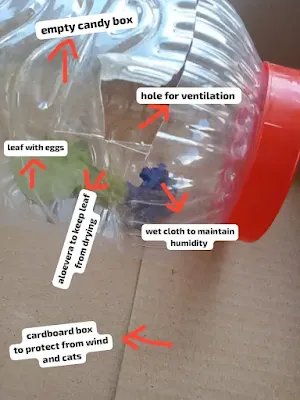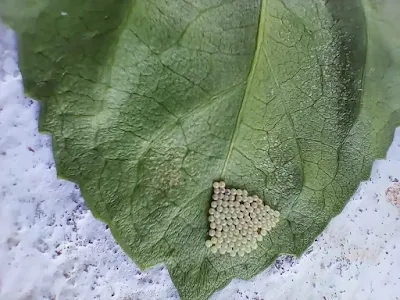aim: studying developmental stages of butterfly.
date of collection: 10 October
location: Warangal
leaf: hibiscus leaf
name of data collector: Deekshith
Progress
eggs collected: 10th october
larval stage (eggs hatched): 13th october (3 days)
Pupa Stage: -
Adult Stage: -
October 10 2024
today I was on terrace to pluck some hibiscus leaves. found some eggs on the back side of a leaf (103 eggs in total). the next thought that crossed my mind after seeing those eggs is these have to be butterfly eggs. they do look similar to butterfly eggs but can't be sure until they develop into one. lets hope they are butterfly eggs.
then I visited a nearby shop to get an empty plastic candy box. I cut two holes for ventilation. put the petiole of leaf in an aloevera gel graft to prevent it from wilting. I put the leaf with the aloevera and a wet cloth(to maintain the humidity of the air inside the box) in the box. now I put the lid back. put the entire box in an empty, sturdy carboard box so that the almost empty plastic box won't fly off due to wind and to give some mechanical support.
looked up on google but couldn't find any specific butterfly species being associated with hibiscus leaves but
Butterflies choose leaves to lay their eggs on using a combination of visual cues and chemical senses:
- Visual cues: Butterflies use visual cues to locate the host plant.
- Contact chemosensation: After landing on a leaf, butterflies use their feet to sense the leaf's taste to determine if it's suitable.
- Leaf position: Most butterflies lay their eggs on the underside of a leaf. This puts the eggs close to food for the caterpillars that hatch from them.
- Plant health: Butterflies choose healthy plants with enough leaves for the caterpillars to eat.
- Once a butterfly has chosen a leaf, it will lay its egg by drumming the leaf with its forelegs, curling its abdomen, and laying the egg.
 |
| Insect eggs on hibiscus leaf |
october 11 2024
today i bought a magnifying glass to observe eggs and upcoming developmental stages.
eggs -> larva(caterpillars in this case) -> pupa -> adult
I observed small black dots in some the eggs and some of them turned a little reddish color. expecting them to hatch in 3 days as insect's eggs hatch in 3-8 days from the day they are laid. replaced the aloevera graft as the gel shrunk in size.
 |
| Hibiscus Plant from where I collected leaf with eggs |
 |
| black dots showing the development of eggs into larvae |
 |
| CUBE Homelab setup for observing and sheltering eggs and future developmental stages |
october 12 2024
observed a bit large black dots in almost all eggs. sign that eggs are developing into larvae.
 |
| some eggs turned a bit reddish color |
october 13 2024
eggs hatched and caterpillars(1st instar caterpillars) came out. yayy!! as expected they hatched in 3 days. almost all eggs are showing black dots visible to naked eye. a few (about 4 eggs) turned into greenish color.(can we expect them to become different colored butterflies from the rest of them?)
observed movement in caterpillars.
morpholoagical features of caterpillars: black head, white body. multiple legs.
 |
| fresh leaves as food for the hatchlings |
 |
| 4 eggs hatched into larvae (caterpillars) 10:00 AM |
 |
| Cube Homelab Warangal telangana |
- cutter
- tape
- marker
- cardboard
- empty plastic box
 |
| a bigger box to accomodate about 100 larvae |
 |
| about 14 larvae 3:00 PM |
there are small black dots near long larvae(expected to be excreta of the larvae) and perforation of leaf is also observed near long larvae(indicative of larvae feeding on leaf). I added some fresh hibiscus leaves and 2 spinach leaves.
 |
| perforated leaf indicative of lavae feeding on leaf |
 |
| long larvae along with black excreta |
 |
| short larvae with no movement |
 |
| 5 pairs of fleshy legs |
 |
| reference chart from https://entomology.ca.uky.edu/ef017 |
 |
| 3 larvae on spinach leaf |
I added some more fresh leaves to the box.
one was curled up on hibiscus leaf.
 |
| caterpillar |
 |
| Caterpillar |
 |
| Caterpillar curled into a hairy ball |
 |
| Caterpillar curled into a hairy ball |
 |
| White strings on leaf |
 |
| Caterpillar curled into a hairy ball |




0 Comments